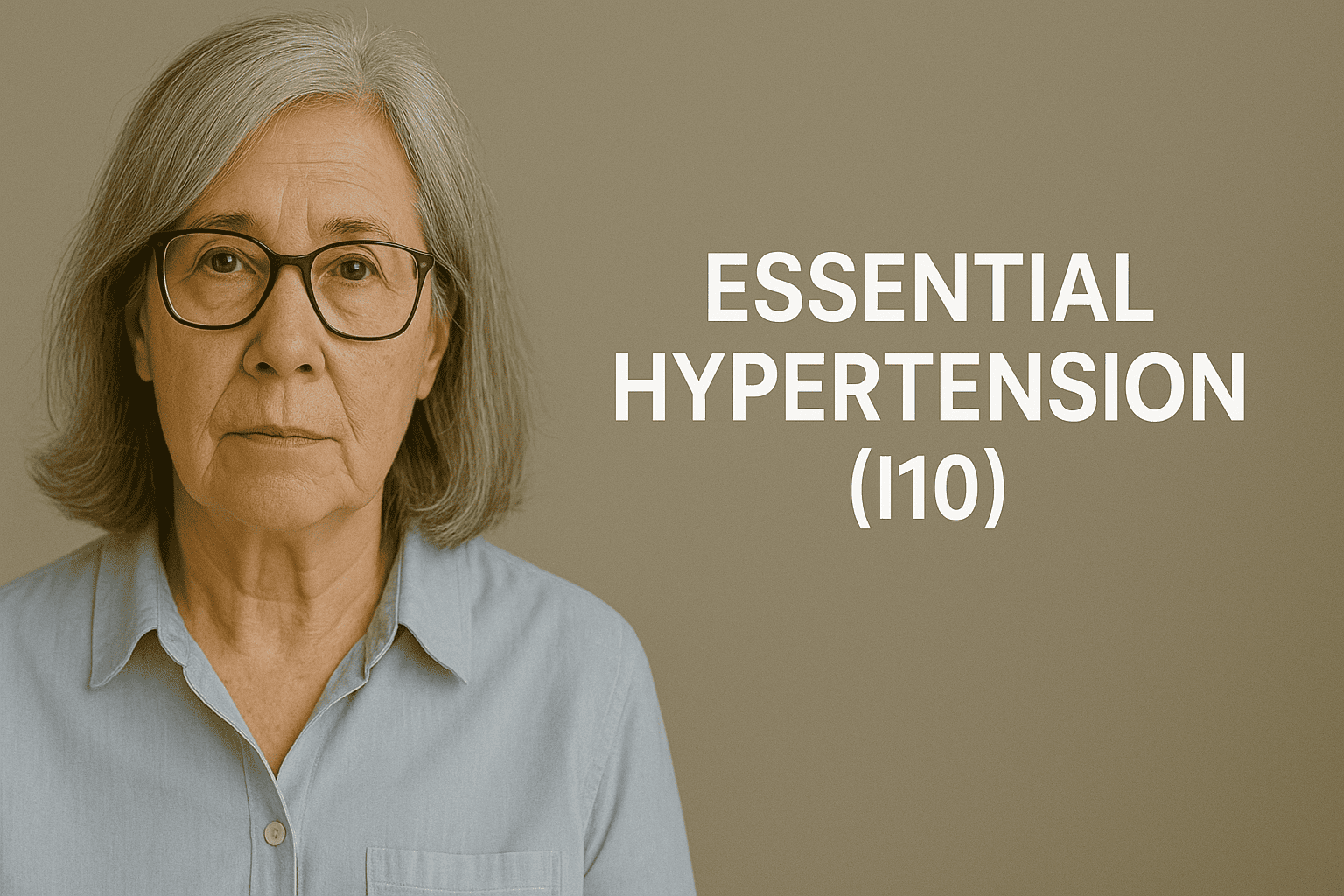Updated on: July 26, 2025
Hypertension (HTN) is a chronic, progressive cardiovascular condition that affects nearly 1 in 3 adults globally. It is often asymptomatic but significantly increases the risk of heart disease, stroke, kidney failure, and mortality. In ICD-10-CM, I10 is used to document essential or primary hypertension, the most common form of high blood pressure without a secondary cause.
This article provides a comprehensive guide for clinicians on when and how to use ICD-10 code I10, documentation best practices, and clinical tips for optimal management.
What Is ICD-10 Code I10?
I10 is the correct code for:
-
Chronic elevated blood pressure
-
Without a known secondary cause (e.g., renal disease, hyperaldosteronism)
-
Asymptomatic or symptomatic hypertension
-
Uncomplicated cases or cases with routine management
Use I10 when documenting essential, primary, or benign hypertension that is not linked to another underlying condition.
How I10 Differs From Other Hypertension Codes
| ICD-10 Code | Condition | When to Use |
|---|---|---|
| I10 | Essential (primary) hypertension | No specific underlying cause |
| I11.9 | Hypertensive heart disease without HF | Hypertension with cardiomegaly, LVH, etc. |
| I12.9 | Hypertensive chronic kidney disease | HTN with stage 1–4 CKD or ESRD |
| I13.0 | HTN heart & kidney disease without HF | Combined heart + kidney involvement |
| R03.0 | Elevated BP reading, no diagnosis | One-time or incidental high reading |
Clinical Scenarios to Use I10
| Patient Scenario | Use I10? | Notes |
|---|---|---|
| Two or more office BP readings >140/90 | ✅ Yes | Confirmed diagnosis |
| On antihypertensives for BP control | ✅ Yes | Even if BP is well controlled |
| Elevated BP without diagnosis (first-time visit) | ❌ No | Use R03.0 instead |
| HTN with CKD stage 3 | ❌ No | Use I12.9 + N18.3 |
| HTN with chest pain and ECG shows LVH | ✅ + I11.9 | Consider cardiac involvement |
Documentation Best Practices for I10
To support the use of I10, documentation should include:
-
Two or more elevated BP readings on different dates
-
Patient symptoms (if any)
-
Antihypertensive medications prescribed
-
Lifestyle modification counseling
-
Blood pressure target goals
-
Evidence of compliance or barriers
Sample EHR Note:
“Patient presents for routine follow-up. BP today 146/92. Last visit BP 150/94. No chest pain or shortness of breath. Continues lisinopril 10 mg daily. Diagnosis: Essential hypertension (I10). Will increase dose and reassess in 2 weeks.”
SOAP Note Example – I10
-
S: “Feeling fine. Here for BP check.”
-
O: BP = 152/95; HR = 84; on amlodipine
-
A: Uncontrolled essential hypertension (I10)
-
P: Increase amlodipine to 10 mg daily; start DASH diet; recheck in 2 weeks
Antihypertensive Drug Classes Commonly Used
| Class | Examples |
|---|---|
| ACE Inhibitors | Lisinopril, Enalapril |
| ARBs | Losartan, Valsartan |
| Calcium Channel Blockers | Amlodipine, Diltiazem |
| Thiazide Diuretics | Hydrochlorothiazide, Chlorthalidone |
| Beta Blockers | Metoprolol, Atenolol |
Lifestyle Management to Document
Always include preventive counseling when managing I10:
-
Low-sodium, DASH-style diet
-
Weight loss goals
-
Exercise recommendation (150 min/week)
-
Limit alcohol and caffeine
-
Stress management
-
Smoking cessation (Z71.6 for tobacco counseling)
Common Secondary Codes Used With I10
| Situation | Secondary Code |
|---|---|
| Lipid disorder | E78.5 |
| Obesity | E66.9 |
| Smoking | Z72.0 or F17.210 |
| Diabetes | E11.9 |
| CKD Stage 1–5 or ESRD | N18.x |
| LVH or cardiomegaly on ECG/Echo | I51.7 |
When Not to Use I10
| Scenario | Use Instead |
|---|---|
| One-time high BP reading only | R03.0 – Elevated BP |
| Hypertension with heart failure | I11.0 + I50.x |
| Hypertension with CKD Stage 3 | I12.9 + N18.3 |
| White-coat hypertension | Document as clinical note only (no code if normal on home BP) |
FAQs
Is I10 used for well-controlled hypertension?
Yes. If the patient has a diagnosis of essential hypertension and is on treatment, continue to use I10 even when BP is within goal range.
Can I use I10 on a telehealth visit?
Yes. As long as BP readings are reviewed or discussed, and medication is managed, I10 is appropriate.
What is the difference between I10 and R03.0?
-
I10 = Confirmed hypertension diagnosis
-
R03.0 = One-time elevated reading, no diagnosis yet
DocScrib Makes Hypertension Documentation Effortless
With DocScrib’s AI-powered charting assistant, clinicians can:
✅ Autodetect chronic I10 diagnosis in SOAP templates
✅ Track BP readings and flag uncontrolled hypertension
✅ Auto-populate medication lists and lifestyle counseling sections
✅ Generate accurate ICD-10 codes and preventive visit documentation
🎯 Book your free DocScrib demo now to modernize your chronic disease management.
Conclusion
ICD-10 Code I10 – Essential Hypertension is among the most frequently used diagnosis codes in clinical practice. Accurate use requires confirming persistent elevated BP, documenting lifestyle interventions, and tracking medication management. With the right tools like DocScrib, clinicians can streamline documentation, optimize billing, and improve long-term outcomes for hypertensive patients.
